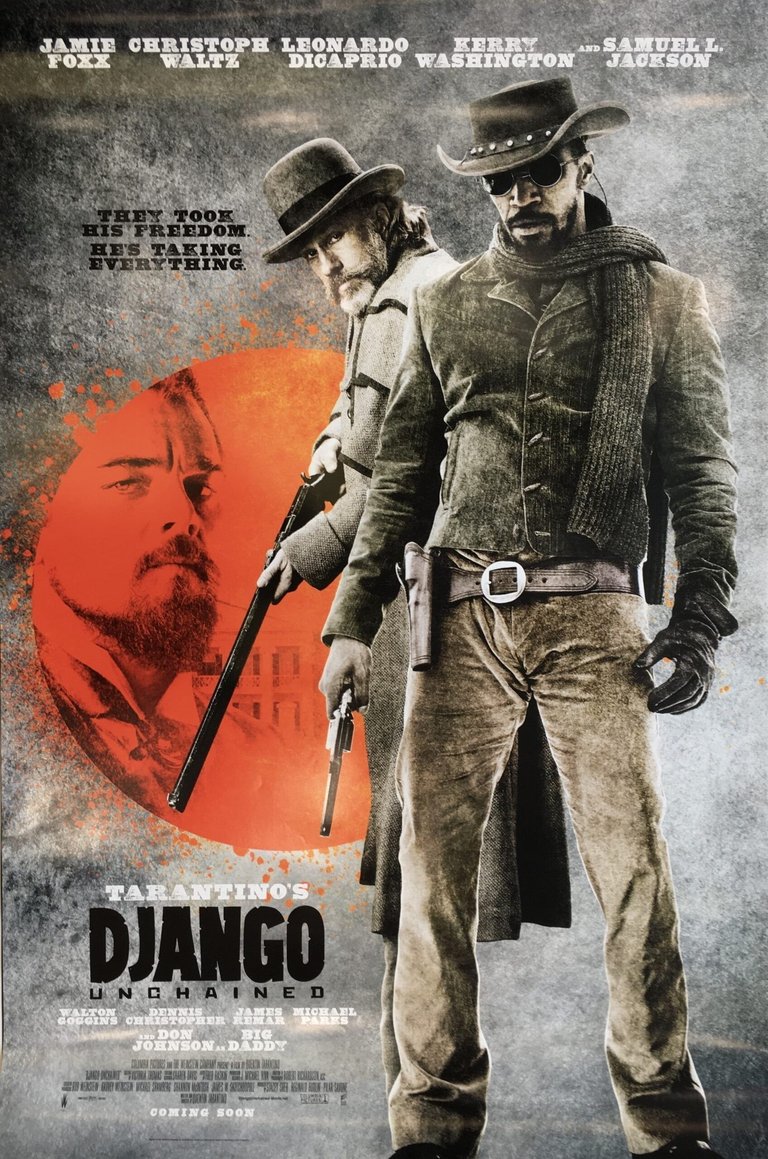Django Unchained - Semiotic Analysis

I've recently been publishing posts regarding hidden meaning and semiotic connotations within film posters. For this post I want to look at a poster for a film released in 2012 from one of my favourite directors Quentin Tarantino. The film is called Django Unchained.
Grasping a basic understanding of semiotics, while it may seem obvious, is the starting point for any intelligent evaluation or appreciation of the semiotic value in films posters. A good starting point is to ensure you are able to identify the meaning behind the signifier and the signified. The signifier pertains to the physical image or text within the sign and the signified explains the idea or concept behind the sign.
Ferdinand de Saussure and Charles Sanders Peirce are two early philosophers in the field of semiotics and are credited with formulating the concept of the signifier and the signified as being inseparable. Semiotics is a media research technique, it can be used as a model of analysis for any area of the mass media.
Fiske defines semiotics as 'essentially a theoretical approach to communication in that its aim is to establish widely applicable principles'. The following semiotic analyses will focus on a film poster (attached) promoting a Quentin Tarantino film – Django Unchained (2012). Part of the analysis will mean exploring the relationship between the image and text, it will evaluate the denotative and connotative meanings being conveyed and it will ensure that the central signifiers are identified and determine the significance of them for their targeted audiences.
So the above poster is very rich in material culture. One of the initial striking things about it is that when looking at this poster the viewer notices the use of non-bright colours. The background is constituted with a patchy grey colour akin to stone, this mildly helps highlight the two characters standing in the foreground of the poster, they themselves also lack a loudness of colour.
The poster makes great use of a rusty/brown colour for the characters we see standing, it's almost as if they have been treated to a grainy sepia filtering. This has the effect of making their appearance more traditional, old and bygone like, and conveys even a hint of nostalgia. It also helps place them more firmly in the context of the western genre.
The colour which is most noticeable is reserved for the centre of the poster. Here we see a red circle revealing the face of a serious looking, even vexed, character.
If we consider the red circle that is placed directly behind the two characters in the foreground, it kind of has parallels with the opening title sequence of the James Bond films. The red circle has a sinister look about it, perhaps reminding us of a sniper looking through the telescopic lense on his gun ready to take aim and fire. The red reminds us of danger but there are also clearly splatters of red around the circle giving us the idea of blood and reinforcing the sinisterism of it all.
Employing coloyrs in this particular way signifies a sense of action which of course is important feature of the film’s central genre. This all helps to contextualize the whole film, and adds to the poster’s many distinguished signs which is a key characteristic of advertising, and whatever platform the advertisement uses there is usually a ‘system of distinct signs’.
The ‘Django Unchained’ poster presents many semiotic opportunities as can be demonstrated from the previous analysis. It is rich in both signifiers and the signified. The poster has many semiotic levels and manages to communicate a number of messages to its audience.
In doing this the poster helps us to gain a wider appreciation of the overall structure of promotional posters for films, and reminds us of the importance of the relationship between semiotic value and the effectiveness of the advert within the poster.
Peace!
Hello.
Welcome to Hive.
To confirm your authorship of the content, could you please mention the word "Hive" in your well-established social media account like Facebook, Instagram, or Twitter (which has not been recently created).
After you add the link, please respond to this comment with the URL link to that website.
You can remove this mention, once we confirm the authorship.
Thank you.
More Info: Introducing Identity/Content Verification Reporting & Lookup
I have just run a plagiarism check on my post and it has come back as 97% unique. The 3% plagiarised part has been picked up probably because it is a direct line from a book. That is the only reason.
Ok, thanks for explaining.
No worries, so would you now be able to remove your comment?
It had already been changed.
Congratulations @peaceandmoney! You have completed the following achievement on the Hive blockchain And have been rewarded with New badge(s)
Your next target is to reach 4000 upvotes.
You can view your badges on your board and compare yourself to others in the Ranking
If you no longer want to receive notifications, reply to this comment with the word
STOPCheck out our last posts:
Greetings @peaceandmoney ,
Thank you for giving us a vocabulary to use when decoding an advertisement for anything really.
We can decode and then apply Principles...hehe
Cheers, Bleujay
Ha! Absolutely you can and I know how much principles mean to you. Thank you for your support, it means a lot.